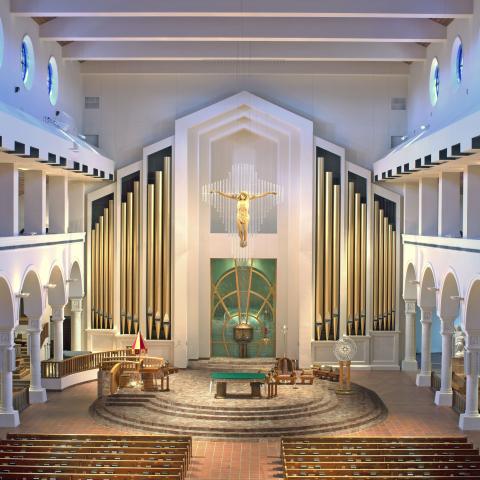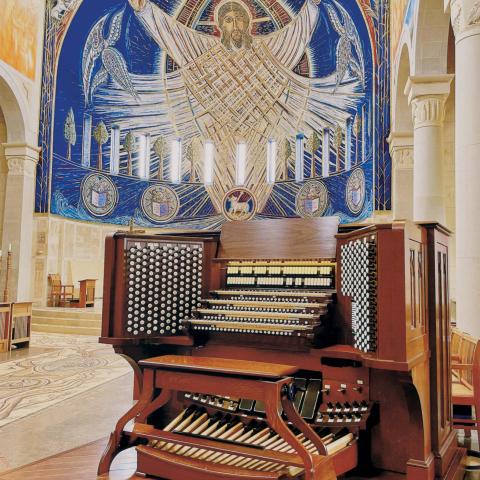Christ Cathedral, Garden Grove, California;
Fratelli Ruffatti, Padua, Italy
Frederick Swann was Director of Music and Organist of the Crystal Cathedral 1982–1998. Upon retirement he was designated Director of Music and Organist Emeritus, and the Aeolian Skinner organ he had been instrumental in securing for the Arboretum was named The Fred Swann Organ.

Resurgam
Few pipe organs in history have received as much attention as has the iconic Fratelli Ruffatti instrument dedicated in May 1982 in the Crystal Cathedral in Garden Grove, California. For many years it was seen and heard weekly by millions of people via television throughout the United States and in over 130 foreign countries on The Hour of Power with Dr. Robert Schuller. In addition to recordings, tens of thousands experienced it live for over three decades in religious services, solo recitals, and a variety of musical presentations.
It is generally known that the plan for this instrument was made by Virgil Fox, who died prior to the installation. The 1977 Ruffatti organ in the former worship space of the congregation was combined with the 1966 Aeolian-Skinner from Philharmonic Hall in New York. The Ruffatti firm added several new divisions, all controlled by what was, at the time, the largest drawknob console in the world—five manuals, 363 drawknobs, 68 coupler tablets, and a myriad of control assists. The organ was an instant success. Many carefully considered changes and additions were made in the early years. The stoplist accompanying this article is the final result. No changes were made during the present renovation.
Over the years the organ was used on a daily basis. It was beautifully maintained by curators John Wilson, Guy Henderson, and Brian Sawyers. Mr. Sawyers continued the work with various helpers for many years after the death of Mr. Wilson and the debilitating illness of Mr. Henderson. The lack of heating and air conditioning in the building resulted in many large windows being open for twenty-four hours most days throughout the year. The accumulated dirt from blowing winds and visits of birds and insects, plus drastic variations in temperature and humidity, took a heavy toll on the organ. Portions ultimately became unusable despite the dedicated efforts of the curators.
In October 2010 Crystal Cathedral Ministries filed for bankruptcy. In February 2012 the entire campus of architecturally stunning buildings—including the 78,000-square-foot Philip Johnson glass cathedral and the original church (now known as The Arboretum)—was purchased by the Roman Catholic Diocese of Orange, California.
You can perhaps imagine the joy felt when the diocese announced that the Hazel Wright Ruffatti in the Cathedral and the Fred Swann Aeolian-Skinner in the Arboretum would be retained, and the cathedral organ would undergo a thorough restoration. Thankfully, both Bishop Kevin Vann and Cathedral Rector Fr. Christopher Smith are organists and realized the significant part the organs could play in the planned dynamic music program of the cathedral. It was soon announced that this would be under the direction of Dr. John Romeri and organist David Ball. A truly significant music ministry has been established by these gentlemen and staff.
In 2012 a committee of diocesan organists and clergy was formed under the direction of Monsignor Art Holquin. After due investigation and consideration, the decision was made to entrust the renovation of the organ to Fratelli Ruffatti. I was asked to be advisor and consultant throughout the several-year project, and I have been honored to accept these duties.
All pipes were cleaned and repaired as necessary, and the chests restored. As mentioned, no changes were made in the specification.
The organ was removed from its chambers starting in December 2013. The work, supervised by Piero Ruffatti, was accomplished by six workers from the Ruffatti factory plus cathedral organ curators Brian Sawyers and Scott Clowes. The assistance of four riggers was required. The pipes were all carefully laid out rank by rank covering the empty floor of the cathedral—an impressive sight—before being carefully packed for shipping.
The console, chests, and most pipes were shipped by sea to the Ruffatti factory in Padua, Italy. The Ruffatti company subcontracted Brian Sawyers to work on some of their pipes plus most of the Aeolian-Skinner pipes and some chest actions in his shop not far from the church. Major cleaning and all necessary repairs were finished by all on schedule, but could not be returned to the cathedral due to unexpected major repairs needed on the 10,000-plus windows. Meanwhile it was decided to keep the five-manual gallery console (M. P. Möller, 1990), and it was sent to Italy where it received an amazing transformation by Ruffatti.
Consequently it was necessary for the entire organ to be placed in a climate-controlled warehouse in May 2016. The organ was finally taken to the cathedral, and re-installation began in January 2019. This was largely completed five months later. However, the enormous amount of wiring and careful detailing continued for months.
Although the entire organ remains in place as before, all visible woodwork portions have been painted a beautiful white color to blend with changes in the cathedral interior. Most exposed wooden pipes were also painted white.
When the organ was first tested we were all shocked. Due to the physical changes made in the cathedral interior, the organ sounded as if it had been designed for another building, which in reality it had been. The new acoustic was excellent, but the organ was much too bold a sound for the space. This necessitated the revoicing of almost every one of the more than 16,000 pipes. This enormous task was accomplished by Francesco Ruffatti and three assistants from the factory working two eleven-hour shifts each weekday for almost three months. The cathedral was closed to visitors except on weekends so that the work could be done in quiet. The flue revoicing was accomplished by the end of November 2019, and the reeds were started in December and continued in February 2020.
The Ruffattis have given unstintingly in every way to assure the success of the entire renovation project.
The remodeled Christ Cathedral was dedicated in mid-July 2019. A large Walker Technical Company digital organ has accompanied all Masses and programs and will be used until Easter 2020. The Walker voices that had been installed in the Ruffatti organ for bona fide reasons and used successfully for years are being replaced with the latest technology.
It is planned that the completed organ will be blessed before the end of Lent and used for the first time during Easter Masses.
A new book, Let everything that has breath praise the Lord—The story of the Hazel Wright Pipe Organ, by Dr. David Crean, will be available for purchase during the dedication weekend events, and may be ordered at a later date. It will consist of the history of other organs over the years in the buildings of the Crystal Cathedral congregation, with major and detailed emphasis on the Hazel Wright organ in the cathedral.
Finally, a bit about the most frequently asked question over the years. Many have wondered about the problems associated with the tuning of the organ. Keeping the organ sounding well was a challenge ever since the initial installation. The tuning was always done in evening hours. The tuning held well, but on warm mornings it was not possible to couple unenclosed and enclosed divisions. I always hoped for cloudy or overcast Sunday mornings, as coupling was then possible. By most afternoons, heat rendered the organ almost unusable. But, as soon as the sun went down the tuning quickly settled in perfectly.
This is why recitals were always played in the evening. When it was announced that all windows in the remodeled building would be sealed and air conditioning installed, we became very hopeful. But, since the organ is located at such a variety of heights and locations in the building, it has so far been impossible for the air conditioning to reach them all. Consequently, the same challenges still exist of having all divisions maintain the same pitch at all times. This will continue to be worked on; meanwhile, learned knowledge and experience will be helpful for the most effective use of the organ.
Since the publishing of this article, the schedule for dedication has been postponed. For up-to-date information: www.christcathedralmusic.org or www.hazelsback.org or call 714/620-7912.
CHANCEL (North) ORGAN includes:
Great, Swell, Choir, Positiv, Solo, Bombarde, Percussions (partial), Pedal
GALLERY (South) ORGAN includes:
Gallery Great, Celestial, String, Percussions (partial), Gallery Pedal
EAST ORGAN includes: Gospel
WEST ORGAN includes: Epistle
GREAT (Manual II, unenclosed)
16′ Montre
16′ Kontra Geigen
16′ Bourdon
8′ Diapason
8′ Principal Major
8′ Principal
8′ Flûte Harmonique (TC)
8′ Spitzflöte
8′ Spitz Celeste
8′ Holz Gedeckt
51⁄3′ Gross Quinte (TC)
4′ Oktav
4′ Octave
4′ Flûte Ouverte
4′ Flûte à cheminée
3-1⁄5′ Gross Tierce
2-2⁄3′ Quinte
2-2⁄3′ Sesquialtera II
2-2⁄3′ Jeu de Tierce II
2′ Fifteenth
2′ Super Octave
2′ Blockflöte
1-1⁄3′ Mixture IV–VI
1-1⁄3′ Ripieno IV
2⁄3′ Cimbalo IV
1⁄2′ Zimbel IV
16′ Contre Trompette
16′ Posaune (ext 8′ Trompete)
8′ Trompette
8′ Trompete
8′ Herald Trumpet (Bombarde)
4′ Clairon
Tremulant
Sub
Unison off
Super
GALLERY GREAT (Manual II, unenclosed)
8′ Grand Montre
8′ Principal
8′ Holzgedeckt
4′ Octave
4′ Koppelflöte
2′ Fifteenth
1-1⁄3′ Nineteenth
1′ Twenty-second
1-1⁄3′ Fourniture V
1⁄2′ Zimbel IV
16′ Sub Trumpet (ext 8′ Trumpet)
8′ Trumpet
8′ Millenial Trumpet
8′ Herald Trumpet (Bombarde)
4′ Clairon (ext 8′ Trumpet)
Gallery Great on Choir
Gallery Great on Swell
Gallery Great on Solo
Gallery Great on Celestial
Gallery Great off II
Tremulant
Sub
Unison off
Super
SWELL (Manual III, enclosed)
32′ Contre Gambe *
16′ Gambe *
16′ Flûte Courte
16′ Quintaton
8′ Montre
8′ Principal
8′ Bourdon
8′ Flûte Couverte
8′ Viole de Gambe
8′ Gambe Celeste
8′ Salicional
8′ Voix Celeste
8′ Erzähler
8′ Erzähler Celeste
4′ Prestant
4′ Octave
4′ Cor de Nuit
4′ Flûte à Pavillon
2-2⁄3′ Nazard
2′ Doublette
2′ Flûte à bec
1-3⁄5′ Tierce
1-1⁄3′ Larigot
1-1⁄7′ Septième **
1′ Piccolo
8⁄9′ Neuf
2′ Plein Jeu III
1-1⁄3′ Mixture V
2⁄3′ Cymbale III
8′ Cornet de Récit V (wired)
16′ Bombarde
16′ Contre Trompette (ext 2ème Tpt)
16′ Basson
8′ Première Trompette
8′ Deuxième Trompette
8′ Voix Humaine
8′ Hautbois
8′ Hautbois d’Orchestre
4′ Premier Clairon
4′ Deuxième Clairon
Tremulant
Sub
Unison off
Super
2 drawkobs prepared
CHOIR (Manual I, enclosed)
16′ Gemshorn
8′ Viola Pomposa
8′ Viola Celeste
8′ Flauto Dolce
8′ Flauto Celeste
8′ Cor de Nuit
4′ Prinzipal
4′ Koppelflöte
2-2⁄3′ Rohrnazat
2′ Prinzipal
2′ Zauberflöte
1-3⁄5′ Tierce
1-1⁄3′ Larigot
2⁄3′ Scharff IV
16′ Fagotto
8′ Petite Trompette
8′ Millenial Trumpet (Gallery)
8′ Clarinet
4′ Fagotto (ext 16′ Fagotto)
Tremulant
Sub
Unison off
Super
Great–Choir Transfer
POSITIV (Manual V, unenclosed)
16′ Bourdon (Great)
8′ Prinzipal
8′ Rohrflöte
4′ Prinzipal
4′ Spillflöte
2′ Oktav
1-1⁄3′ Larigot
1′ Sifflöte
1′ Scharff IV
1⁄4′ Terz Zimbel III
16′ Fagotto (Choir)
8′ Krummhorn
8′ Tuba Mirabilis (Bombarde)
4′ Rohrschalmei
Tremulant
Sub
Unison off
Super
SOLO (Manual IV, enclosed)
8′ Gambe
8′ Gambe Celeste
8′ Doppelflöte
8′ Major Flute (TC) (Gallery)
4′ Orchestral Flute
2-2⁄3′ Quintflöte (TC)
2′ Fife
8′ French Horn
8′ English Horn
8′ Corno di Bassetto
8′ Cor de Bassett (Gallery)
Tremulant
Gallery Flute Trem
Sub
Super
BORSTWERK
6 drawknobs prepared
BOMBARDE (Manual IV, unenclosed)
8′ Flûte d’Arvella (TC, Ped 4′ Spillflöte)
16′ Tuba Profunda (TC, 8′ T. Mirabilis)
8′ Tuba Mirabilis
8′ Herald Trumpet
8′ Millenial Trumpet (Gallery Great)
4′ Tuba Clairon (ext 8′ Tuba Mirabilis)
BOMBARDE (Manual IV, enclosed with Solo)
4′ Major Octave
1-1⁄3′ Harmonics VI
1-1⁄3′ Fourniture III
1⁄2′ Cymbel IV
16′ English Post Horn (ext 8′)
8′ English Post Horn
8′ Trompette Harmonique
4′ Clairon Harmonique
Unison off
CELESTIAL (Manual V, enclosed)
16′ Bourdon Doux (ext 8′ Fl à cheminée)
8′ Principal
8′ Flûte à cheminée
8′ Viola Pomposa
8′ Viola Celeste
8′ Flauto Dolce
8′ Dolce Celeste (TC)
4′ Principal
4′ Italian Principal
4′ Flûte Traversière
2-2⁄3′ Sesquialtera II (TC)
2′ Doublette
2′ Octavin
1-1⁄3′ Plein Jeu V
2⁄3′ Cymbale IV
4⁄5′ Jeu de Clochette II
16′ Contre Trompette (ext 8′ Trompette)
16′ Ranquette
8′ Trompette
8′ Cor Anglais
8′ Cromorne
4′ Clairon
4′ Chalumeau
Tremulant
8′ Harpe *
Sub
Unison off
Super
Positiv Off
1 drawknob prepared
STRING (Manual I, enclosed)
16′ Viola
16′ Viola Celeste
8′ Dulciana
8′ Unda Maris
8′ Salicional
8′ Voix Celeste
8′ Dulcet
8′ Dulcet Celeste
8′ Muted Viole I
8′ Muted Viole Celeste I
8′ Muted Viole II
8′ Muted Viole Celeste II
8′ Violoncello
8′ Cello Celeste
8′ Rohrpfeife
4′ Nachthorn
8′ Voix Humaine
Tremulant
Sub
Unison off
Super
String Off I
String on Great
String on Swell
String on Solo
String on Celestial
String Tutti
1 drawknob prepared
ECHO (floating, expressive)
8′ Violes Forte II *
8′ Fernflute *
8′ Vox Amorosa II *
4′ Divinare *
8′ Vox Seraphique II *
2-2⁄3′ Rohr Nazat *
8′ Anthropoglossa *
8′ Oboe d’Amore *
Tremulant
Sub
Super
Echo on V
Echo on IV
Echo off III
Echo on II
Echo on I
Echo to Pedal
EPISTLE (floating)
8′ Principal *
4′ Octave *
2′ Mixture IV–V *
8′ Mounted Cornet V
16′ Trompette en chamade
8′ Trompette en chamade
4′ Trompette en chamade
2′ Trompette en chamade
16′ Pedal Principal *
Sub
Epistle on Choir
Epistle on Great
Epistle on Swell
Epistle on Solo
Epistle on Celestial
GOSPEL (floating)
8′ Principal *
4′ Octave 4 *
2′ Super Octave *
1-1⁄3′ Mixture IV *
16′ Trompette en chamade
8′ Trompette en chamade
4′ Trompette en chamade
16′ Pedal Principal *
Sub
Gospel on Choir
Gospel on Great
Gospel on Swell
Gospel on Solo
Gospel on Celestial
PERCUSSIONS
Bells on IV *
Bells on Pedal *
Rossignol
Etoile de Grand matin
Glockenstern
Celestial Cloches
8′ Choir Harp *
4′ Choir Celesta *
Great Chimes *
Carillon on Pedal (bell tower)
Carillon I (bell tower)
Carillon IV (bell tower)
PEDAL
64′ La Force (resultant)
32′ Double Diapason
32′ Kontra Geigen (ext 16′ Geigen)
32′ Contre Gambe (Swell) *
32′ Contra Bourdon *
32′ Grand Cornet IV (wired)
21-1⁄3′ Diapente Grave (ext 16′ Geigen)
16′ Contre Basse
16′ Diapason (ext 32′ Double Diapason)
16′ Principal
16′ Montre (Great)
16′ Geigen (Great)
16′ Gambe (Swell) *
16′ Subbasso
16′ Bourdon
16′ Flûte Courte (Swell)
16′ Quintaton (Swell)
16′ Gemshorn (Choir)
10-2⁄3′ Quinte
8′ Principal
8′ Octave
8′ Principal (Positiv)
8′ Violone
8′ Geigen (Great)
8′ Bourdon (ext 16′ Bourdon)
8′ Bordone
8′ Spitzflöte
8′ Flûte Courte (Swell)
8′ Gemshorn (Choir)
5-1⁄3′ Octave quinte (ext 10-2⁄3′ Quint)
4′ Octave
4′ Choralbass
4′ Principal (Positiv)
4′ Spireflöte
4′ Spillflöte
2′ Octave
2′ Spindleflöte (ext 4′ Spillflöte)
5-1⁄3′ Fourniture IV
2-2⁄3′ Ripieno VI
1-1⁄3′ Acuta II
32′ Contre Bombarde *
32′ Kontra Posaune
32′ Contra Fagotto *
16′ Posaune (ext 32′ Kontra Posuane)
16′ English Post Horn (Bombarde)
16′ Contre Trompette (Great)
16′ Bombarde (Swell)
16′ Basson (Swell)
16′ Fagotto (Choir)
8′ Trompette
8′ Trompete
8′ Herald Trumpet (Bombarde)
8′ Fagotto (Choir)
8′ Krummhorn (Positiv)
4′ Trompette (ext 8′ Trompette)
4′ Klarine (ext 8′ Trompete)
4′ Krummhorn (Positiv)
4′ Rohrschalmei (Positiv)
Pedal FFF (tutti)
1 drawknob prepared
GALLERY PEDAL
32′ Untersatz *
32′ Contre Basse *
32′ Grand Harmoniques IV (wired)
16′ Open Wood
16′ Montre La Tour (ext Gallery Great Grand Montre)
16′ Bourdon
16′ Bourdon Doux (Celestial)
16′ Viola (String)
16′ Viola Celeste (String)
16′ Gemshorn *
8′ Viola (String)
8′ Viola Celeste (String)
8′ Prestant (Gallery Great)
8′ Bourdon (ext 16′ Bourdon)
4′ Basse de Chorale (Gallery Great)
2-2⁄3′ Mixture V (ext Gallery Gt Fourn V)
32′ Contre Bombarde *
16′ Bombarde
16′ Contre Trompette (Celestial)
16′ Sub Trumpet (Great)
16′ Ranquette (Celestial)
8′ Trompette (ext 16′ Bombarde)
8′ Millenial Trumpet (Gallery Great)
4′ Clairon (ext 16′ Bombarde)
COUPLERS
Great to Pedal 8 – 4
Swell to Pedal 8 – 4
Choir to Pedal 8 – 4
Solo to Pedal 8 – 4
Positiv to Pedal 8 – 4
Gallery Great to Pedal 8 – 4
Celestial to Pedal 8 – 4
String to Pedal 8 – 4
Epistle to Pedal 8
Gospel to Pedal 8
Swell to Great 16 – 8 – 4
Choir to Great 16 – 8 – 4
Solo to Great 16 – 8 – 4
Positiv to Great 8
Celestial to Great 16 – 8 – 4
Pedal to Great 8
Great to Choir 8
Swell to Choir 16 – 8 – 4
Solo to Choir 16 – 8 – 4
Positiv to Choir 8
Celestial to Choir 16 – 8 – 4
Choir to Swell 16 – 8 - 4
Solo to Swell 16 – 8 – 4
Positiv to Swell 8
Celestial to Swell 16 – 8 – 4
Positiv to Solo 8
Celestial to Solo 16 – 8 – 4
Great on Solo 8
Selected accessories
Pedal divide
Echo Expression to Solo
Full Organ
String Expression on Celestial
String Expression on Choir
String Expression on Swell
String Expression on Solo
All Swells to Swell
21 Generals, divisionals, reversibles, silencers, silencer cancel
Gallery in Control / Split / Chancel in Control
Tutti
Chancel Tutti
Digital stops marked with *
Stop preparations marked with **
*Digital stops were added over the years to help support congregational singing in the distant East and West galleries, and also to reinforce the Pedal due to the poor acoustics for bass frequencies. Those digital voices have now been replaced with the latest technology, under a separate contract not involving Fratelli Ruffatti.
263 pipe stops, 265 pipe ranks, 16,000 pipes
Builder’s website: www.ruffatti.com
Cathedral website: https://christcathedralcalifornia.org
Cathedral music website: http://christcathedralmusic.org
Cathedral organ website: http://hazelsback.org







